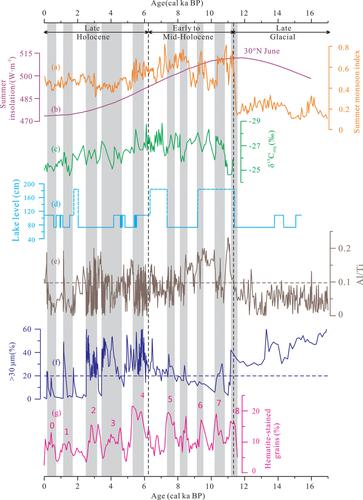当前位置:
X-MOL 学术
›
Acta Geol. Sinica Engl. Ed.
›
论文详情
Our official English website, www.x-mol.net, welcomes your
feedback! (Note: you will need to create a separate account there.)
Grain‐size Age Model in Reconstructing Orbital‐ and Suborbital‐scale Climate Changes on the Northeastern Tibetan Plateau Since the Late Glacial
Acta Geologica Sinica-English Edition ( IF 3.5 ) Pub Date : 2020-06-26 , DOI: 10.1111/1755-6724.14534 Yuan LI 1, 2 , Hui ZHAO 1
Acta Geologica Sinica-English Edition ( IF 3.5 ) Pub Date : 2020-06-26 , DOI: 10.1111/1755-6724.14534 Yuan LI 1, 2 , Hui ZHAO 1
Affiliation

|
Reconstructions of past climatic changes on the northeastern Tibetan Plateau (NETP) can provide insights into the Asian summer monsoon (ASM) variability. However, the regional climate changes on both orbital and suborbital time scales since the late Glacial remain controversial. Here we present the results of high‐resolution geochemical and grain‐size analyses of a sediment core from Genggahai Lake, a small, shallow lake in this area. Changes of the accumulation rate of the core sediments show a similar trend with variations of the coarse fraction. Accordingly, the chronological framework is constructed using a grain‐size age model. In addition, the histories of chemical weathering and aeolian activity since the late Glacial are reconstructed based on the Al/Ti ratios and coarse fractions, respectively. The results suggest that an enhanced chemical weathering and a weakened aeolian activity occurred on the NETP under a warmer, wetter climate during the early to mid‐Holocene (11.3–6.3 ka cal BP), compared with the late Glacial (17.1–11.3 ka cal BP) and the late Holocene (6.3 ka cal BP to present), which responded mainly to the strengthened ASM on orbital time scale. In addition, the synchronous occurrences of weakened chemical weathering, low lake level and intense aeolian activity on suborbital time scale reflect several episodes of weakened ASM. Furthermore, these episodes largely coincide with the centennial‐ to millennial‐scale cold events in the North Atlantic, which demonstrates the close connection between the ASM and the cooling at high latitudes.
中文翻译:

冰川晚期以来重建东北青藏高原轨道和亚轨道规模气候变化的粒度年龄模型
对青藏高原东北部(NETP)过去气候变化的重建可以提供有关亚洲夏季风(ASM)变异性的见识。然而,自冰川晚期以来,区域气候在轨道和亚轨道时间尺度上的变化仍然引起争议。在这里,我们介绍了该地区一个小而浅的湖泊耿嘎海的沉积物核的高分辨率地球化学和粒度分析结果。核心沉积物积累速率的变化与粗粒分数的变化趋势相似。因此,使用粒度年龄模型构建了时间框架。此外,冰川期以来的化学风化和风成活动的历史分别基于铝/钛比和粗粒分数进行了重建。结果表明,与晚冰河时期(17.1-11.3 ka cal)相比,全新世早期至中期(11.3-6.3 ka cal BP)在温暖,湿润的气候下,NETP发生了化学风化作用增强,风沙活动减弱。 BP)和晚期全新世(目前为6.3 ka cal BP),这主要是对轨道时间尺度上增强的ASM的反应。此外,在亚轨道时间尺度上同时发生的化学风化作用减弱,湖泊水位低和风沙活动强烈的同时发生,反映了ASM减弱的若干事件。此外,这些事件在很大程度上与北大西洋的百年至千年级冷事件相吻合,这表明了ASM与高纬度的冷却之间的紧密联系。与晚冰河时期(17.1-11.3 ka cal BP)和新世晚期(6.3 ka cal BP)相比,全新世早期至中期(11.3–6.3 ka cal BP)较湿润的气候。轨道时间尺度上的ASM。此外,在亚轨道时间尺度上化学风化减弱,湖水位低和风沙活动强烈的同步发生反映了ASM减弱的若干事件。此外,这些事件在很大程度上与北大西洋的百年至千年级冷事件相吻合,这表明了ASM与高纬度的冷却之间的紧密联系。与晚冰河时期(17.1-11.3 ka cal BP)和新世晚期(6.3 ka cal BP)相比,全新世早期至中期(11.3–6.3 ka cal BP)较湿润的气候。轨道时间尺度上的ASM。此外,在亚轨道时间尺度上同时发生的化学风化作用减弱,湖泊水位低和风沙活动强烈的同时发生,反映了ASM减弱的若干事件。此外,这些事件在很大程度上与北大西洋的百年至千年级冷事件相吻合,这表明了ASM与高纬度的冷却之间的紧密联系。这主要是对轨道时间尺度上增强的ASM的反应。此外,在亚轨道时间尺度上同时发生的化学风化作用减弱,湖泊水位低和风沙活动强烈的同时发生,反映了ASM减弱的若干事件。此外,这些事件在很大程度上与北大西洋的百年至千年级冷事件相吻合,这表明了ASM与高纬度的冷却之间的紧密联系。这主要是对轨道时间尺度上增强的ASM的反应。此外,在亚轨道时间尺度上同时发生的化学风化作用减弱,湖泊水位低和风沙活动强烈的同时发生,反映了ASM减弱的若干事件。此外,这些事件在很大程度上与北大西洋的百年至千年级冷事件相吻合,这表明了ASM与高纬度的冷却之间的紧密联系。
更新日期:2020-06-26
中文翻译:

冰川晚期以来重建东北青藏高原轨道和亚轨道规模气候变化的粒度年龄模型
对青藏高原东北部(NETP)过去气候变化的重建可以提供有关亚洲夏季风(ASM)变异性的见识。然而,自冰川晚期以来,区域气候在轨道和亚轨道时间尺度上的变化仍然引起争议。在这里,我们介绍了该地区一个小而浅的湖泊耿嘎海的沉积物核的高分辨率地球化学和粒度分析结果。核心沉积物积累速率的变化与粗粒分数的变化趋势相似。因此,使用粒度年龄模型构建了时间框架。此外,冰川期以来的化学风化和风成活动的历史分别基于铝/钛比和粗粒分数进行了重建。结果表明,与晚冰河时期(17.1-11.3 ka cal)相比,全新世早期至中期(11.3-6.3 ka cal BP)在温暖,湿润的气候下,NETP发生了化学风化作用增强,风沙活动减弱。 BP)和晚期全新世(目前为6.3 ka cal BP),这主要是对轨道时间尺度上增强的ASM的反应。此外,在亚轨道时间尺度上同时发生的化学风化作用减弱,湖泊水位低和风沙活动强烈的同时发生,反映了ASM减弱的若干事件。此外,这些事件在很大程度上与北大西洋的百年至千年级冷事件相吻合,这表明了ASM与高纬度的冷却之间的紧密联系。与晚冰河时期(17.1-11.3 ka cal BP)和新世晚期(6.3 ka cal BP)相比,全新世早期至中期(11.3–6.3 ka cal BP)较湿润的气候。轨道时间尺度上的ASM。此外,在亚轨道时间尺度上化学风化减弱,湖水位低和风沙活动强烈的同步发生反映了ASM减弱的若干事件。此外,这些事件在很大程度上与北大西洋的百年至千年级冷事件相吻合,这表明了ASM与高纬度的冷却之间的紧密联系。与晚冰河时期(17.1-11.3 ka cal BP)和新世晚期(6.3 ka cal BP)相比,全新世早期至中期(11.3–6.3 ka cal BP)较湿润的气候。轨道时间尺度上的ASM。此外,在亚轨道时间尺度上同时发生的化学风化作用减弱,湖泊水位低和风沙活动强烈的同时发生,反映了ASM减弱的若干事件。此外,这些事件在很大程度上与北大西洋的百年至千年级冷事件相吻合,这表明了ASM与高纬度的冷却之间的紧密联系。这主要是对轨道时间尺度上增强的ASM的反应。此外,在亚轨道时间尺度上同时发生的化学风化作用减弱,湖泊水位低和风沙活动强烈的同时发生,反映了ASM减弱的若干事件。此外,这些事件在很大程度上与北大西洋的百年至千年级冷事件相吻合,这表明了ASM与高纬度的冷却之间的紧密联系。这主要是对轨道时间尺度上增强的ASM的反应。此外,在亚轨道时间尺度上同时发生的化学风化作用减弱,湖泊水位低和风沙活动强烈的同时发生,反映了ASM减弱的若干事件。此外,这些事件在很大程度上与北大西洋的百年至千年级冷事件相吻合,这表明了ASM与高纬度的冷却之间的紧密联系。











































 京公网安备 11010802027423号
京公网安备 11010802027423号